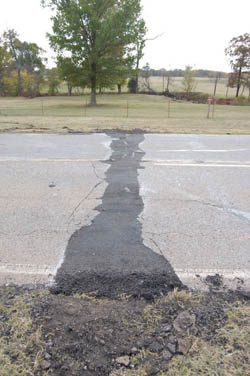Posted: Aug 12, 2014 2:25 PM EDTUpdated: Aug 12, 2014 2:25 PM EDTPosted by: Jennifer Cope, Producer
The U.S. Geological Survey (click here) is warning that the chances of a damaging earthquake in Oklahoma have increased significantly.Experts have been studying the earthquakes in our state and have found the number of tremors has been growing since 2009.The moderate quakes could mean that a "big one" is possible and it could hit without warning.The U.S.G.S. has pointed to wastewater injection as a contributing factor to the earthquakes.The petroleum industry's answer to devastating the land in the USA is cope. It would be just too bad if this occurred to the foundation of a home.
A 2011 magnitude 5.7 quake near Prague, Okla., apparently triggered by wastewater injection,buckled U.S. Highway 62. (John Leeman)A new study in the journal Geology (click here) is the latest to tie a string of unusual earthquakes, in this case, in central Oklahoma, to the injection of wastewater deep underground. Researchers now say that the magnitude 5.7 earthquake near Prague, Okla., on Nov. 6, 2011, may also be the largest ever linked to wastewater injection. Felt as far away as Milwaukee, more than 800 miles away, the quake—the biggest ever recorded in Oklahoma--destroyed 14 homes, buckled a federal highway and left two people injured. Small earthquakes continue to be recorded in the area....Published Online July 3 2014Science 25 July 2014: Vol. 345 no. 6195 pp. 448-451 DOI: 10.1126/science.1255802
The U.S. Geological Survey (click here) is warning that the chances of a damaging earthquake in Oklahoma have increased significantly.Experts have been studying the earthquakes in our state and have found the number of tremors has been growing since 2009.The moderate quakes could mean that a "big one" is possible and it could hit without warning.The U.S.G.S. has pointed to wastewater injection as a contributing factor to the earthquakes.The petroleum industry's answer to devastating the land in the USA is cope. It would be just too bad if this occurred to the foundation of a home.
A 2011 magnitude 5.7 quake near Prague, Okla., apparently triggered by wastewater injection,buckled U.S. Highway 62. (John Leeman)A new study in the journal Geology (click here) is the latest to tie a string of unusual earthquakes, in this case, in central Oklahoma, to the injection of wastewater deep underground. Researchers now say that the magnitude 5.7 earthquake near Prague, Okla., on Nov. 6, 2011, may also be the largest ever linked to wastewater injection. Felt as far away as Milwaukee, more than 800 miles away, the quake—the biggest ever recorded in Oklahoma--destroyed 14 homes, buckled a federal highway and left two people injured. Small earthquakes continue to be recorded in the area....Published Online July 3 2014Science 25 July 2014: Vol. 345 no. 6195 pp. 448-451 DOI: 10.1126/science.1255802
Sharp increase in central Oklahoma seismicity (click here) since 2008 induced by massive wastewater injection
August 12, 2014
By Bryan Rupp
In what seems a never ending string of earthquake activity in Oklahoma and now Kansas has been documented during the past 30 days. The following is a list of earthquakes totalling 86 that have shook the two states with a minimum magnitude of 2.5 in the past 30 days. This list does not include the smaller quakes with magnitudes of less than 2.5.
The strongest quake was a 4.3 magnitude that was felt across a wide and vast expanse of Oklahoma and Kansas. It's epicenter was 24 km WSW of Medford, OK....
How many times do the geologists of Oklahoma have to conduct studies to prove the danger in this technology?
August 11, 2014
By Janelle Stecklein
OKLA. CITY — Within the next few months (click here) the state’s top earth scientists plan to add 20 new seismic-monitoring stations to better track temblors in Oklahoma.
Austin Holland, a research seismologist with Oklahoma Geological Survey, said eight permanent and 12 temporary stations will enhance the agency’s existing network.
“The more stations we have, the better information we can get about the earthquakes,” Holland said. “We want to be consistent in monitoring so that we can say we can see everything above magnitude 2 across the state.”
When Holland first started working at the Geological Survey in 2009, he estimates the state averaged about 1.5 earthquakes per year. Now, he said, it’s more like 1.5 per day....

